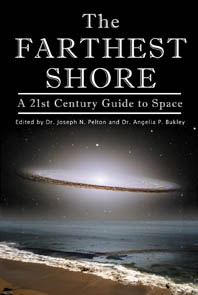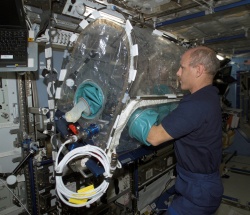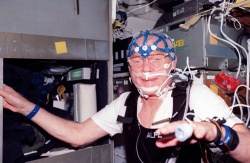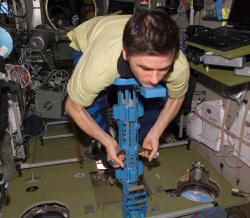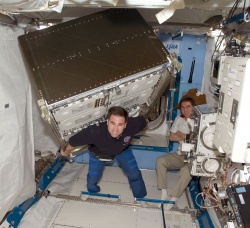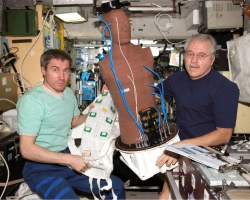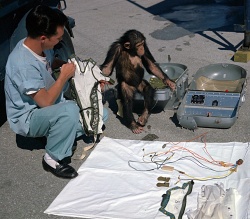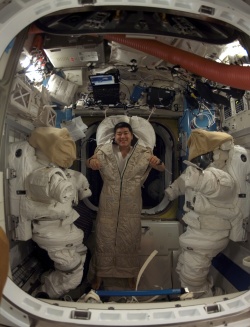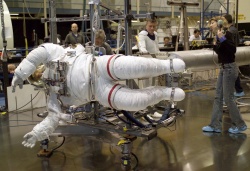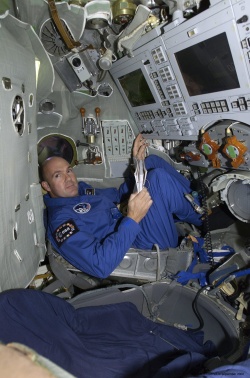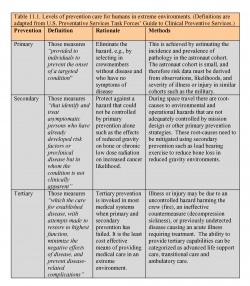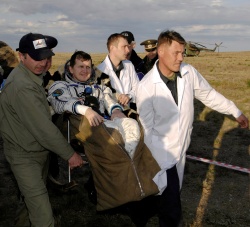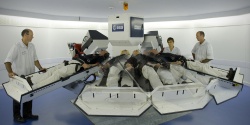The Farthest Shore – Chapter Eleven Life in Space for Life on Earth
From The Space Library
Chapter Eleven - Life in Space for Life on Earth
Gilles Clément and Douglas Hamilton
“I spent a lot of my time working in the American module, and [the Russian cosmonaut] would stay in the Russian segment working on his things, and we’d meet up at meal times. So, it actually worked out very well.” -- Leroy Chiao, ISS Expedition 10 Commander
11.0 The Challenges of Life in Space
One of the key reasons we go into space is to understand life here on Earth. But to understand life in space we need to know about more than medicine, physiology and biology. When we go into space we find that these traditional life sciences are closely linked with the sciences of physics, chemistry, geology, engineering, and astronomy among others. Space life sciences are not straightforward. A lot of very smart people, with diverse and sometimes unlikely degrees in science and engineering, get involved. We need mechanical engineers to design suits for astronauts, we need electrical engineers to design our experiments, and on it goes.
Space life sciences research helps us to live and work in space. Five decades of experimentation with biosatellites and more than 310 crewed spaceflights with about 550 astronauts from various countries around the world have led us to understand many of the effects that the space environment has on living organisms - from microbes to people. That is the good news! The bad news is the more we understand the more questions we have. The truth is that we still don’t know some basic mechanisms concerning life in space. Even so, the field of space life sciences has already benefited many people on the ground. The new challenge of long-duration planetary missions helps us to explore fundamental questions about gravity’s role in the formation, evolution, and even the aging process of life on Earth.
11.1 Objectives of Space Life Science
Life sciences are specifically devoted to understanding the living world, from bacteria and plants to humans, including their origins, history, characteristics and habits. You name it, and it is probably in someone’s space life sciences research agenda. Through its evolution, life on Earth has experienced only a constant one-g environment. The influence of this omnipresent force, the Earth’s gravity, on life is still not well understood. We do know that there is a clear biological response to gravity in the structure and functioning of living organisms. The plant world has evolved gravity sensors. Roots grow “down” and shoots grow “up”. Animals have gravity sensors in the inner ear. Many species orient themselves with respect to gravity within a few minutes after fertilization.[1]
To better understand a living system, the scientific method sometimes studies the consequences of changing its environment. Clearly, the removal of gravity is a desirable, even necessary, step toward understanding its role in living organisms. Transition into weightlessness abolishes the stimulus of gravity. This dramatic procedure is physiologically equivalent to shutting off the lights to better study vision. What can be accomplished in such an elegant fashion aloft can never be done in Earth-based laboratories. This method has opened a new field of basic scientific interest, known as “space physiology”. This field of study deals with fundamental questions concerning the role of gravity in living processes. “Space medicine” is another, albeit more applied, research component concerned with the health and welfare of astronauts. These two objectives complement one another, and constitute key elements of the field of space life sciences . We believe that space life sciences open a door to understanding ourselves, our evolution, the working of our world without the constraining barrier of gravity.[2]
11.1.1 Enhancing Fundamental Knowledge
Access to a space laboratory where gravity is reduced aids our research. It allows us to study cellular and molecular mechanisms that are involved in sensing small forces. We begin to understand whether “messages” concerning gravity are transmitted via neural or hormonal signals. How do individual cells perceive gravity? What is the threshold of perception? Gravitational biologists try to answer these questions. Results of flight experiments suggest that a gravity level as low as one one-hundredth of normal gravity (or 0.01g) is perceived by cells through physical changes both in the liquid medium surrounding cells in a culture and in cellular structures that sense and “oppose” mechanical loads (See Figure 11.1). Exactly how the change in gravity then affects cellular functions is yet to be determined. The answer to this question is not only relevant to understanding the fundamental processes in normal cell physiology, but also to the study of certain diseases. This includes the study of such age-related concerns such as bone loss, cancer, or immune system deficiencies.[3]
Although many embryos split along planes in a direct relationship to the pull of gravity, we do not understand the role gravity plays throughout the reproductive cycle. We do not know, for instance, whether gravity, per se , is essential to fertilization, cell division and the differentiation between cell function, or whether gravity plays a key role in the formation of various tissues and organs.[4] Thus we would like to know whether any organism can be effectively fertilized and then develop to form viable reproductive cells for the next generation, all in the environment of space.
The formation of the various tissues and organs spans several developmental stages. The formation of specialized cells continues after birth or hatching and well into the post-natal period. If normal development does not occur, the priority is to determine which period of development is most sensitive to microgravity. For each organ system, there appears to be a critical period during which development can be disrupted by relatively small environmental stresses. Experiments on neonate (newborn) rats in space have shown abnormal development of righting reflexes and locomotion.[5] Bone metabolism and the formation of blood cells might also suffer permanent effects if the gravity stimulus were withdrawn during the appropriate stage of fertilization, birth or early development.
Regenerative processes are also fundamental developmental responses to post-natal tissue loss and injury. In many situations, these processes are a response to changes in the environment to which the individual is exposed. Understanding the role of gravity not only in ontogeny (i.e. the development of the individual) but also in phylogeny (i.e. the evolution of species) indicates the need for studies on various species in space for successive generations and indeed over a long period of time.
Such research leads to a host of intriguing questions. If we were to change one or more external factor such as gravity, what difference might this make? Would it be possible to modify the blueprints contained in the genome and change some characters of the species? Might all humans become boneless, jellyfish-like organisms, after many generations in space?[6]
11.1.2 Protecting the Health of Astronaut
For more than four decades crewed spaceflight has proven that humans can survive and function in the space environment for missions longer than one year. Russian cosmonauts hold all the longer-term endurance records, although they were more than wobbly when they returned to Earth after over a year in orbit.
Future missions to the Moon and Mars, however, will last two or three times longer. While there were many unknown health and performance hazards in the earliest space missions, experience obtained from the aviation medicine community was used to determine that these hazards were not totally uncontrolled and therefore acceptable for spaceflight.
“People who were concerned with the future of man in space quickly became aligned with one of two points of view. On the one side, there were the more cautious and conservative members of the medical and scientific community who genuinely believed man could never survive the rigors of the experience proposed for him. The spirit in the other camp ranged from sanguine to certain. Some physicians, particularly those with experience in aeronautical systems, were optimistic. […] It became the task of the medical team to work toward bringing these divergent views toward a safe middle ground where unfounded fears did not impede the forward progress of the space program, and unbounded optimism did not cause us to proceed at a pace that might compromise the health or safety of the individuals who ventured into space.”[7]
In the early space missions, physiological and clinical studies were predominantly performed pre- and post-flight. Occasionally in-flight biomedical monitoring provided the means to verify that humans could carry out additional tasks, such as extravehicular activity, rendezvous and docking, robotic manipulation, exercise, and function without significant impairment, as discussed by astronauts Rusty Schweickart and Jeffrey Hoffman in Chapter 3.
After a while, human spaceflight seemed to become more commonplace. In truth, however, spaceflight is far from commonplace; it is certainly not free from risk. About 1.5% of the crewed spaceflights that have lifted nearly 1250 people to orbit -and beyond -resulted in lethal accidents. Indeed 3.5% of all the 550 astronauts and cosmonauts that rocketed into space died.
In any event, after the early missions were completed the spaceflight goals became less operational and thus more focused on research. A good deal of the research has been to examine the effects of spaceflight on living organisms, including humans. Because of this research, we now know there are specific impacts on the health and performance of humans both during spaceflight and even several years afterward (See Figure 11.2).
As was amply demonstrated by Pasteur, as well as countless successors, basic research is a boon to both medicine and agriculture. In the space life sciences, key unknowns abound. The process of bone demineralization in space as seen in humans and animals is a progressive phenomenon. This is not only a serious medical problem but involves questions of biological research. We now know that weightlessness gives rise to questions about abnormalities in the development of bones, shells, and special crystals (such as the otoliths of the inner ear). The study of such abnormalities should provide us with important insights. Research areas that may seem quite arcane, such as the process of biomineralization and the control of gene transcription, will pay off in terms of new understanding. This research may help us to care for bedridden patients, to find new ways to treat a variety of diseases, and to gain many insights into how genetic processes work. Many patients who are bedridden lose muscle mass and suffer bone demineralization, yet many hibernating animals do not. It is important to understand why these animals are protected from bone loss. Even though astronauts exercise daily on the International Space Station (ISS), many still lose a significant amount of bone mass (See Figure 11.3).
In some astronauts, this loss of bone mass is never recovered after returning to Earth, while in other cases bone mass is partially restored. Some scientists and physicians are investigating whether drugs used to prevent bone loss in the elderly should be used on astronauts. These drugs are not without their side effects. Thus, some scientists believe that we should be examining those animals that seem to be protected from such problems while hibernating.
11.1.3 Developing Advanced Technology
In addition to the scientific need to study basic plant and animal interactions with gravity, there is a practical need to study their responses to gravity as well. These responses are essential to our ultimate ability to sustain humans for a year or more on the surface of extraterrestrial bodies or in spaceflight missions of long duration. On such missions, re-supply is not possible, and any new food must be produced in space. Experiments during long-term space missions will determine which plants and animals are most efficient and best suited for our needs. For instance, can soybeans in space germinate, grow normally, and produce an optimum crop of new soybeans for food and new seed for ensuring crops? We believe that new knowledge of this biological cycling, plus the development of equipment for water and atmosphere recycling and management of waste in space, will also bring important benefits for people on Earth.
Research in biotechnology relies on the manipulation of cells of living organisms. The purpose of these manipulations is typically to produce useful molecules, natural or artificial, in useful quantities. Specifically, the objective is to develop new biological molecules for specific uses. This may, for instance, be to improve plant yields and enhanced animal products through genetic alteration. Recombinant techniques, for example, make it possible to produce natural or artificially mutated versions of proteins, which can exhibit a wide range of activities and uses, both scientific and medical. In many cases these can be produced in large quantities. The techniques essential to these manipulations are applied in the liquid or aqueous environments within a cell, and are subject to the constraints of fluid dynamics and specific rules that we call “transport processes”. Gravity affects biological systems through its influence on the transfer of mass and heat, particularly in fluid dynamics and transport functions. Gravity also impacts cell structure and function. Consequently, we believe that being able to conduct experiments in microgravity can, and will, lead to new knowledge about biological systems. This in turn should lead to improvements in experimental techniques.[8]
Another potential application is in the field of “crystallography”. Detailed knowledge of the three-dimensional architectures of biological macromolecules is required for a full understanding of their functions. We also seek to understand the chemical and physical effects of these large organic molecules that allow them to achieve these functions. Protein crystallography is currently the principal method for determining the structure of complex biological molecules. In essence we need relatively large, well-ordered single crystals to achieve a clear and “useful morphology”. (This is to say we need to understand the molecules’ form and their function). Crystals with these qualities may be difficult to produce for a variety of reasons. Some of these crystals may be influenced by gravity, through density-driven convection and sedimentation. Protein crystal growth experiments conducted in space have provided persuasive evidence that improvements can, in fact, be realized for a variety of protein samples.
However, the continuous production of such biological materials (bioprocessing) on a commercial scale in space has so far proved not to be compatible with the large cost of access to space. Space bioprocessing thus remains marginal today as a viable industrial application, but its potential very much remains. Improved bioprocessing techniques coupled with cheaper access to space may change the business equations in future years. (See chapter 11 that discusses, in greater detail, commercial space opportunities.) Ground-based genetic engineering in mammalian or human embryo cells is now a very strong alternative to space bioprocessing. There continue to be rapid advances in many areas achieving purification methods, including “immuno-affinity chromatography”.[9]
11.2 The Space Environment and Its Effects on Living Organism
The deep space environment is really a very hostile and difficult place for people as well as the organic matter that we know here on Earth. This environment includes deadly radiation, microgravity, vacuum, and magnetic fields. Then there are the local planetary environments for the manned missions to the Moon and Mars that present some major challenges as well. For more details on the characteristics of these environments, the reader could refer to the excellent review of this subject by Eckart.[10]
11.2.1 Microgravity
The presence of Earth creates a gravitational field that acts to attract objects with a force inversely proportional to the square of the distance between the center of the object and the center of Earth. When we measure the acceleration of an object acted upon only by Earth’s gravity at its surface, we commonly refer to it as “1 g” or one “Earth gravity.” This accel-eration is approximately 9.8 m/s2. A microgravity environment is one that imparts to an object a net acceleration that is small (such as 10–6g, or one one-millionth of the Earth’s gravity) (See Figure 11.4).
Microgravity can be created in two ways. Because gravitational pull diminishes with distance, one way to create a microgravity environment is to travel far away from Earth (almost 17 times farther away than the Moon). This approach is impractical, except for automated spacecraft. However, the act of free-fall creates a more practical microgravity environment. Free-fall can be achieved in Earth-based drop towers, parabolic aircraft flights, and Earth-orbiting laboratories. In practice, the residual acceleration will range from about 10–2g on board an aircraft in parabolic flight, to better than 10–6g on board an orbiting spacecraft.
However, after a few seconds or minutes of low-g in aircraft, drop tower facilities and small rockets, Earth “gets in the way” and the free-fall stops. To establish microgravity conditions for long periods of time, one must use satellites in Earth orbit, i.e. in a trajectory that arcs above Earth at the right speed to execute a falling path parallel to the curvature of Earth. When the spacecraft is in a state of free-fall - in orbit - around the Earth, its occupants are in a microgravity environment. However, the acceleration due to gravity at the low Earth orbit (at ~400 km altitude) is only reduced from its surface value.
11.2.2 Other Factors of the Space Environment
Beside microgravity, during spaceflight living organisms are also affected by ionizing radiation (see chapter 5), isolation, confinement, and changes in circadian rhythms (24-hour day/night cycle). In plants, for example, spaceflight offers the unique opportunity to separate the gravitational input from other environmental stimuli known to influence plant growth, such as the effects of light (phototropism), water (watertropism), and electric and magnetic fields. Spaceflight thus gives us the opportunity to distinguish between the various “tropic” responses, i.e. to investigate the mechanisms of stimulus detection and response.
The absence of natural light in spacecraft may have significant effects on humans too. A typical person spends his days outdoors, exposed to light from the Sun (filtered through the ozone layer), including a small but important amount of mid- and near-ultraviolet light. This ambient light also includes approximately equal portions of the various colors of visible light. Beside brightness, this light has numerous additional physiological and psychological effects. For example, light exerts direct effects on chemicals near the surface of the body, such as activating Vitamin D as well as destroying certain compounds such as melanin. This light also exerts indirect effects via the eye and brain to trigger circadian rhythms, secretion from the pineal organ, endocrine operations and even our moods. Many people exhibit major swings in mood seasonally, in particular toward depression in the fall and winter when the hours of daylight become short. Research is exploring the key question as to whether prolonged exposure to inadequate lighting (i.e., the wrong spectrum, or too low an intensity, or too few hours per day of light) may adversely affect human mood and per-formance.
The effects of spaceflight on biological specimens might also be related to other factors. Even the gentlest of launch vehicles produces enormous amounts of noise and vibration, plus elevated g forces. This increased “g force” continues until orbital velocity is achieved and also occurs during reentry into Earth’s atmosphere. Once in orbit, machines and astronauts continue to produce vibrations and noise that are difficult to control. Biologists who are trying to focus their research on the effects of microgravity try to control other external factors (such as, for example, fluctuations in atmospheric pressure as astronauts enter and exit a spacecraft). For instance, onboard centrifuges can simulate the level of gravity found on Earth’s surface in control specimens to create a baseline against which to test the other specimens when they are weightless.
11.2.3 The Radiation Environment
The broad spectrum of radiation encountered in space ranges widely. It varies from extreme ultraviolet radiation, X-rays, and high-energy particles encountered as electrons, neutrons, protons, and heavy ions with high charges. Additional radiation is created in high-energy collisions of primary particles with spacecraft material. Although all forms of radiation are of significance, we focus on the high-energy ionizing radiation encountered during space missions. Other radiation effects are addressed in greater detail in the book by Eckart.
The highest energy radiation comes in the form of galactic cosmic rays and solar particles. Galactic radiation comes from supernova explosions and is composed of protons, electrons, and fully ionized nuclei of light elements. These high-energy particles interact with the nuclei of the nitrogen and oxygen atoms of the atmosphere, resulting in a highly complex secondary radiation, which irradiates the whole surface of the globe. The solar energetic particle radiation originates from solar flares or in shock waves associated with mass ejections from the Sun’s corona (see Chapter 5). This radiation consists of 95% protons, electrons and heavy ions of high energy and speed. Space missions that include travel within or through the Van Allen belts also add a third source of radiation. The Van Allen belts consist of protons and electrons trapped by the geomagnetic field. A phenomenon of special importance for missions in low Earth orbit is the South Atlantic Anomaly, in which the charged particles are drawn closer to the Earth than over other regions of the globe due to the weaker geomagnetic field.
The mechanisms whereby ionizing radiation affects cells are either direct (particles impacting a vital target molecule and directly transferring their energy), or indirect (particles impacting other molecules, e.g., water, to yield longer-lasting, very-reactive free radicals, i.e., unpaired electrons). At the cellular level, when DNA strands break following an impact with a high-energy particle, non-rejoined breaks can lead to cell death, whereas incorrectly rejoined breaks can lead to mutation. The temporal and spatial characteristics of the radiation energy determine the quantity and quality of damage. Single-strand breaks can normally repair. However, double-strand breaks with close single hits or a high-density energy hit do not repair. Cells that are actively dividing (mitosis) are the most vulnerable. High-energy particles, with their large capacity to transfer their energy along the path, can generate a high percentage of double-strand DNA breaks. The effects are widespread and can lead to the death of numerous cells along the track.
The ozone layer, the Earth’s magnetosphere and the Van Allen belts block most of the harmful cosmic and solar radiation. Without these key filters above us, radiation would otherwise bombard people and animals on Earth in a disastrous way. These protective shields help to prevent runaway mutation of our genes. These “naturally occurring protective systems” are thus critical to the well being of our species and indeed of all the fauna and the flora across the planet. Extensive holes in the ozone layer observed in the past two decades coupled with the evidence of increased mutation among some species is considered an environmental risk that we must address—and sooner rather than later.
Chromosome damage and abnormalities due to high-energy particle hits have been clearly observed in plants and animals flown in space. Some studies showed that standard radiation-protective chemicals didn’t stop the damage. It is hard to determine if these effects in lower organisms will lead to tumor induction, life shortening, or chromosome aberration in organisms with longer life spans. On the other hand, experiments with protozoa and bacteria suggest that small doses of radiation may be beneficial, because small doses elicit stress responses that have been shown to increase DNA repair.[11]
Micro-lesions (or “tiny cuts”) of cultured retina cells from human eyes that were produced by single heavy ions were first discovered via spaceflight experiments. These findings initiated biological investigations using particle accelerators on Earth. However, the results of ground-based and space studies are often conflicting. For example, more mutations were observed in larvae of Drosophila exposed to an “artificial” radiation source while in orbit compared to ground controls. This difference suggests the possible existence of a combined effect of radiation and other environmental factors, like microgravity.[12]
Clearly there is a difficulty of differentiating between the effects of several factors inevitably present during spaceflight. For this reason, some biological effects, and their protection, can be studied only in space. NASA and ESA developed to this end a “phantom torso” to study the effects of radiation at tissue level, both during activities inside and outside the ISS (See Figure 11.5). Dosimeters are mounted where critical organs are located (head, heart, liver, and kidneys). These dosimeters record the level of radiation received as a function of time. Other instruments mounted on the outside of the ISS measure the energy, the spectrum and the frequency of particles that first hit the ISS shielding. (The higher the frequency of electromagnetic radiation, the smaller is the wavelength, and the higher the energy.) As radiation goes through the station wall and the phantom torso, the radiation is modified. The secondary radiation may have a different effect on tissue than that of the primary radiation. The information gained from the torso experiment will help determine the best types of materials and methods for shielding human crews in space.
All space agencies agree that the effects of space radiation, especially on non-dividing cells of the retina and central nervous system, must be assessed before long-duration human missions beyond the Earth’s magnetosphere are attempted. For a human mission to Mars, considerably better quantitative data on radiation dose rates beyond the magnetosphere are still required. In particular, better predictability of the occurrence and magnitude of energetic particles from the Sun is needed, since radiation from the largest solar flares can be life threatening in a relatively short time.
11.2.4 Life Support System
Protecting humans from radiation, vacuum, extreme temperatures, and noise requires the use of life support equipment and technologies such as radiation shielding, pressurized and isolated living quarters, and space suits. In addition, certain basic physiological needs must be met for human beings to stay alive in space. On Earth, these needs are met by other life forms, in conjunction with chemical processes. These life forms (such as bacteria and vegetation) and associated chemical reactions effectively use human waste products in conjunction with energy from the Sun to produce fresh supplies of food, oxygen and clean water. In the artificial environment of a spacecraft, these natural processes that allow us to live and thrive are not there unless we artificially create them. Food must be available, water recycled (yes, this means reclaiming water from urine), human wastes must be removed, and so on. All this must be done without relying on the natural resources of the Earth’s biosphere.
To date, most space missions have largely relied on a simple “open” system. This meant bringing all necessary food and supplies for the crew, and venting waste products to space, or collecting and storing them for return to Earth. When the point is reached where it is no longer cost effective or logistically possible to re-supply the spacecraft or planetary habitat with water, atmosphere, and food, ways must be found to recycle all these components. This recycling of material is referred to as a “closed” system, and can be achieved using physical-chemical systems or, better, using biological systems.
Trying to recreate the cycles of nature in a relatively small volume is a great technical challenge. Critical questions are being addressed during human missions, such as: How far can we reduce reliance on expendables? How well do biological and physical-chemical life support technologies work together over long periods of time? Is a “steady state” condition ever achieved with biological systems? How do various contaminants accumulate, and what are the long-term cleanliness issues? Eventually, in the case of exploration missions, is it possible to duplicate the functions of the Earth in terms of human life support, without having the benefit of the Earth’s large buffers, such as the oceans, atmosphere, and land mass? How small can the requisite buffers be and yet maintain extremely high reliability over long periods of time in a hostile environment? We must hope that finding answers to these questions might ultimately bring some solutions to Earth’s global environmental problems too.
11.3 The Legacy of Space Life Sciences Research
There is today a rich legacy of space life sciences research that is built on the basis of extensive international, intercultural and interdisciplinary teamwork among scientists and engineers who have worked hard to investigate the many unknowns.
11.3.1 Where We Are
Human spaceflight began in 1961, with Yuri Gagarin’s single orbit of the Earth on board Vostok-1. Since then, astronauts and cosmonauts have spent a considerable amount of time beyond the Earth’s surface. As we write these lines, the total number of days spent in space is close to 50,000 crew days, which corresponds to 135 crew-years. All we know about humans in space corresponds to the lifetime for two single individuals.
Flight durations longer than six months are limited to about 42 individuals, and only four individuals have experienced spaceflights longer than one year. The record of spaceflight duration is currently held by Dr. Valery Polyakov, a Russian physician who spent 437 days during a single mission aboard the space station Mir in 1994-1995. Five years earlier, he had spent 242 days onboard Mir, so his total time spent in space is 679 days, or about 22 months. But this is not the longest duration in space for a single individual. Gennadi Padalka has logged 827 days during five stays on board Mir and the ISS, and he currently holds the all-time cumulative total for days in space (Note: Padalka is scheduled to fly again to the ISS in September 2018 for a six-month mission). His total time, 29 months, corresponds to the duration of exposure to microgravity that will be experienced during a mission to Mars. Although we know that humans can survive for a long time in space, the data collected on the few individuals who have flown these very long missions is extremely limited.
11.3.2 The Pioneers of Space Life Science
The first airplane flights by Clément Ader in 1897 and the Wright Brothers in 1903, that both lasted only a few seconds, are traditionally considered to be the original milestone in manned flight and aerospace medicine. About 120 years before these events, however, a hot air balloon carried the first animal and human passengers during a flight that lasted more than two hours. Ironically, the first human to fly in a balloon described, for the first time, the symptoms of hypoxia experienced in aerospace medicine (altitude sickness, increase in heart rate, fatigue), and also became the first casualty after his balloon accidentally crashed in a later flight.[13]
By the middle of the 20th century, as human spaceflight began to be seriously considered, most scientists and engineers projected that if spaceflight became a reality it would build upon logical building blocks. First, a human would be sent into space as a passenger in a capsule (Projects Vostok and Mercury). Second, the passengers would acquire some control over the space vehicle (Projects Soyuz and Gemini). Third, a reusable space vehicle would be developed that would take humans into Earth orbit and return them. Next, a permanent space station would be constructed in a near-Earth orbit utilizing a reusable space vehicle. Finally, lunar and planetary flights would be launched from the space station using relatively low-thrust and reusable (and, hopefully, lower cost) space vehicles. Today’s vision for space exploration is largely based on this approach.[14]
As with balloon flights, animals were sent up in rockets before humans, to test if a living being could withstand and survive a journey into space. The first successful spaceflight for live creatures came after World War II, when the former Soviet Union launched a sounding rocket with a capsule including a monkey and eleven mice. A few attempts to fly animals had been made before in the nose cones of captured German V-2 rockets during U.S. launch tests, but something always went wrong with these tests. These early attempts to study space life sciences sought to study the effects of high acceleration, weightlessness, and exposure to radiation at high altitude.[15]
In 1958, Sputnik-2 carried the first living creature into orbit. This dog named Laika was equipped with a comprehensive array of telemetry sensors. These sensors gave continuous physiological information to tracking stations. Laika’s flight demonstrated that spaceflight was tolerable to animals. Other dogs, as well as mice, rats and a variety of plants were then sent into space for longer and longer durations. Monkeys rode U.S. missiles and Mercury capsules as the first step toward putting a human into space (see Figure 11.6). While these animals were in space, instruments also monitored various physiological responses as the animals experienced the stresses of launch, re-entry, and the weightless environment. The results of these animal flights showed that cardiac and respiration functions, as evaluated from pulse rate, electrocardiogram and blood pressure records, remained within normal limits throughout the flight. Animals trained in the laboratory to perform various tasks during the simulated acceleration, noise, and vibration of launch and re-entry were able to maintain performance throughout an actual flight. On the basis of these results, it was concluded that the physical and mental demands that astronauts would encounter during spaceflight “would not be excessive”, and the adequacy of the life support system was demonstrated.[16]
11.3.3 Humans in Orbit
In 1958 and 1959 both NASA and the Soviet Union announced that they had selected fighter pilots for their respective space programs. All candidates had endured stringent physical, psychological, and medical examinations. On April 12, 1961, Yuri Gagarin became the first human to orbit the Earth. According to the press release, Gagarin felt “perfectly well” during the weightlessness phase of its single orbit around the Earth. It was noted, however, that “measures” had been taken to protect the spacecraft from the hazards of space radiation. He was followed by Gherman Titov, who flew 17 orbits and, two years later, by Valentina Tereshkova, who became the first woman in space. She remained in space for nearly three days and orbited the Earth 48 times. Unlike earlier Soviet space flights, Tereshkova was permitted to operate the controls manually. Although her spaceflight was announced as successful, it was 19 years until another woman flew in space; she was Svetlana Savitskaya, aboard Soyuz T-7 in 1982.
Soviet Cosmonaut Aleksei Leonov and Astronaut Edward White made space walks in March and June 1965, respectively, and both experienced considerable difficulties to maneuver around and re-enter the spacecraft. (See also the “stories” in Chapter 4 from Astronaut Rusty Schweickart about his spacewalks on Apollo 9 and from Astronaut Jeff Hoffman about his multiple spacewalks to repair the Hubble Space Telescope).
These early flights had made it clear that the body undergoes some real changes during and after a spaceflight of several days in duration. These include such changes to the body as significant cardio-vascular deconditioning (by “deconditioning” we mean the “deterioration” or the reduced state of healthiness experienced by astronauts or cosmonauts during the course of a mission), reduction in red blood cell count, and weight loss. A more complex set of in-flight medical studies was carried out during the subsequent missions, which served as precursors to the lunar missions. In parallel, ground-based studies were initiated to simulate some of the conditions of spaceflight to better understand these changes. These studies uti-lized bed rest and water immersion as a means of simulating microgravity. In addition, biosatellite missions of longer duration were launched with animals on board.
With the lunar missions, a medical program was developed which would make provision for emergency treatment during the mission in case a serious illness occurs. Indeed, during the orbital flights, it was always possible to abort the mission and recover the astronaut within a reasonable time should an in-flight medical emergency occur. This alternative was greatly reduced during Apollo. The events of Apollo-13 showed that this medical program proved effective. Biomedical findings of the Apollo program revealed decreased post-flight exercise capacity and red blood cell number, a loss of bone mineral, and the impact on the body of extra-vehicular activity. In addition, symptoms of space motion sickness such as nausea and vomiting were experienced by both astronauts and cosmonauts. These observations raised concerns about future human spaceflights, especially if they were of long duration. These results constituted the starting point for detailed life science investigations in the Skylab and Salyut space stations program in the 1970s.[17]
From 1981 the Space Shuttle provided the opportunity to test many more crewmembers. As the first spacecraft designed to be used again and again, the Space Shuttle gave space life scientists the ability to conduct more experiments, as well as to repeat and refine those experiments. However, with the Space Shuttle, other concerns appeared. The Space Shuttle was different from previous spacecraft because it returned to Earth by landing on a runway. Critical issues existed concerning the ability of crews to perform the visual and manual tasks involved in piloting, landing and leaving the Shuttle after a long exposure to weightless conditions. It was later found that the astronauts-pilots were able to pilot and manually land the Space Shuttle, as long as the flight duration did not exceed two weeks. A mission longer than 14 days gave rise to concerns about being able to conduct all of the necessary operations flawlessly.
In April 2001, an American engineer and millionaire, Dennis Tito, paid some US$20 million to fly on a Soyuz and spent eight days on board the International Space Station (ISS). (See more about space tourism and that mission in Chapter 4). His trip precipitated a great deal of controversy when NASA and the other ISS partners objected to a “tourist” visit in the middle of a critical series of assembly operations at the ISS. The ISS partners reluctantly gave their approval for the visit that was going to take place, with or without their approval, in return for a promise by the Russians that there would be new standards for paying visitors in the future. Since then, several other space tourists have visited the ISS onboard Soyuz. The U.S.-based firm Space Adventures in fact, brokered all these arrangements for flights on Russian vehicles.
Unofficial “tourists” had already flown on several occasions both on the U.S. Space Shuttle (a senator, a congressman, a teacher, and a prince from Saudi Arabia) as well as aboard the Salyut and Mir space stations (a reporter, an engineer from a chocolate company, and several guests from allied countries). Europe took the opportunity of a paying visitor on the Soyuz to allow its astronauts to have regular access to the ISS for one week at a time. These were the so-called “Taxi” missions. Despite less stringent physical requirements and only a short training period, space tourists seem to have adapted well to spaceflights lasting a week or two, once the symptoms of space motion sickness had abated.
11.3.4 Surviving the Odyssey
Early predictions of the response of humans to spaceflight assumed that space adaptation would be analogous to human disease processes rather than to normal physiology. The predictions made by scientists about the ability of humans to endure spaceflight were indeed dire. Despite ground-based studies proving the contrary, there was true concern that the g forces of launch and reentry (6 to 8 g for the earliest rockets) would render human passengers unconscious, severely impaired, or even result in their death. The mystique of this alien environment was so great that many feared a psychotic breakdown when separated from mother Earth. Some physicians voiced concerns that body functions such as swallowing, urination, and defecation would be impaired or impossible in the absence of gravity (although anyone who has ever swallowed while standing on their head or hanging upside down could have proven otherwise). They also felt that the bowels would not work without gravity, the heart might cavitate like a pump or beat so irregularly as to cause severe problems, sleep would be impaired (see Figure 11.7), and muscles, including the heart, would become so weakened as to prohibit return to Earth (Wolfe 1979).[18]
Fortunately, all these predictions over-estimated the physiological problems associated with spaceflight.
The first space missions showed, however, that with the proper protection humans could survive a journey into space. Biomedical changes of significance observed during spaceflight were predominantly related to the effects of microgravity. Nevertheless, other phenomena were closely monitored as well. These factors included high launch and re-entry gravitational forces, radiation exposure, and psychological stress. To illustrate these many physiological changes, Dr. Susanne Churchill, in one of her lectures at the International Space University, has used the following “story line” to describe the space journey of a hypothetical space traveler who experiences all the known problems:
“So, let us take a journey with our hypothetical astronaut. She is in excellent health and fully trained for the rigors of her 3-month increment on board ISS. […] Launch occurs as anticipated and less than ten minutes from lift-off, she finds herself floating in the weightlessness of space. Without warning, however, she suddenly vomits and is overwhelmed with intense symptoms of motion sickness: nausea, a sense of dizziness, and disorientation. Her symptoms become worse when she moves about in the cabin or sees one of her fellow crewmembers floating upside-down. She takes some pills and is getting ready for sleep. However, when looking in the mirror above the sink, she realizes that her eyes seem smaller, her face is round and puffy, and her neck veins bulging. The good news is that her wrinkles have disappeared and she looks younger. When undressing, she notices that her legs look like sticks. […]
“So, let us take a journey with our hypothetical astronaut. She is in excellent health and fully trained for the rigors of her 3-month increment on board ISS. […] Launch occurs as anticipated and less than ten minutes from lift-off, she finds herself floating in the weightlessness of space. Without warning, however, she suddenly vomits and is overwhelmed with intense symptoms of motion sickness: nausea, a sense of dizziness, and disorientation. Her symptoms become worse when she moves about in the cabin or sees one of her fellow crewmembers floating upside-down. She takes some pills and is getting ready for sleep. However, when looking in the mirror above the sink, she realizes that her eyes seem smaller, her face is round and puffy, and her neck veins bulging. The good news is that her wrinkles have disappeared and she looks younger. When undressing, she notices that her legs look like sticks. […] Within a couple of days, the motion sickness symptoms begin to subside, through her face and legs remain changed. Rendezvous and transfer to the ISS occur without incident and she starts to settle for a 3-month stay on board with her two fellow crewmates. Personal hygiene is limited to “sponge” bathing; food becomes bland tasting and she must add spices for interest. There are experiments to monitor and several hours of exercise daily on the treadmill or cycle ergometer. After a few weeks, however, the routine is boring and it becomes harder and harder to keep up with the exercise. The more she looks out of the window, the more she longs for the sounds of rain and wind, and the smells of flowers. The crew starts to argue about the smallest things. One planned space walk has to be cancelled because of a persistent irregular heartbeat in one of the crewmember. Since that incident, this crewmember seems to be withdrawing from the others. The weekly videoconferences with family and friends are eagerly anticipated, but she won-ders why there has been no communication from her youngest child for several weeks. Has something happened? […] But at last the time to return approaches. When donning her reentry space suit, she realizes it is too tight because she has grown a few centimeters. After landing, our traveler reports an unbelievable sense of “heaviness” and finds herself unable to stand up unassisted from her seat, much less walk down the stairs. Her heart is beating fast; she sweats and almost faints. Even after several days of rehabilitation, muscle weakness is very evident; she quickly feels short of breath and is constantly thirsty. Weight loss that occurred in space is rapidly disappearing, but her physician tells her that she had lost much of bone density in her hips and that her immune system seems to be impaired. Now she is concerned because she remembers that the various bacterial colonies they were studying on board the ISS laboratories showed explosive growth rates! Several months later, though, all her body functions seem to have readapted to Earth gravity. This story is not meant to discourage anyone from wanting to be an astronaut. In reality, not all people experience all of the adverse effects of spaceflight. It is rather meant to show how little we really know about the human body’s response to spaceflight and how very dangerous this new environment can be.”[19]
11.4 Challenges Facing Humans in Space
Human travel in space is not easy. Some believe that robots should do most of the exploration, a job they can do cheaper and perhaps even better than humans.
11.4.1 The Role of Humans in Space Exploration
The debate over space exploration is often framed as humans versus robots. Some scientists fear that sending humans to the Moon and Mars might preclude the pursuit of high quality science. On the other hand, some proponents of human exploration believe that if we undertake as much science as possible using robots this would diminish interest in sending humans. Man vs. machine remains a big question in space exploration. However, space exploration should be thought of as a partnership to which robots and humans each contribute important capabilities. Robots are particularly good at repetitive tasks; they excel at gathering large amounts of data and doing simple analyses. Although difficult to reconfigure for new tasks, robots are highly predictable and can be directed to test hypotheses suggested by the data they gather. However, robots are subject to mechanical failure, design and manufacturing errors, and, of course, errors can be made by their human operators. Certainly, as robots improve in terms of their mobility, functionality and “thinking” capabilities, they will be able to do more.
Robotic operation on the Moon is not a problem, with only a few seconds of delay between command and response. For Mars, radio communication delays between Mars and Earth (on the order of 40 minutes round trip) pose a serious problem for teleoperation maneuvers. However, “self-aware machines” and machines that are artificially intelligent should make such problems more manageable.
People, in contrast to today’s robots are capable of integrating and analyzing diverse sensory inputs and of making connections that machines overlook. Humans respond well to new situations and adapt their strategies accordingly. They do better than automated systems in any number of situations, either by deriving a creative solution from a good first-hand look at a problem or by delivering a more brainless kick in the right place to free a stuck antenna! For the next decade humans will remain better at “connecting the dots” than our increasingly capable machines.
Today we can still say that humans are more adept at field science, an activity that demands all these properties. Obviously, humans have a clear role in doing geological fieldwork and in searching for life on Mars. However, humans are less predictable than robots; they are subject to illness, homesickness, and stress from confinement, hunger, and thirst. They need protective space suits and pressurized habitats. Hence, they require far greater and more complicated and expensive support than do robots. In the future space agency planners may have to address questions like: What do we do when it is ten times less costly to send a robot to Mars but the machine is only half as capable as a human? A clear-cut answer is impossible because there are “apples to oranges” comparisons. Cost, mobility, agility, intuitive capability and more must be considered.
Automatic probes have indeed returned spectacular results, but it is wrong to compare these directly with the outcomes of human spaceflights. Space life science, a rather recent discipline, suffers from the small number of subjects studied and the many confounding factors that are difficult to control.
“But life sciences data obtained in low Earth orbit studies will be practically utilized for going further (such as establishing a Mars base) or for improving our knowledge of clinical and aging disorders on Earth, long before information on the magnetic field of Neptune.” [20]
The opportunities for in-depth studies in space life sciences have indeed been sparse. This is simply the nature of the current space program, with much to do and only a few flight opportunities that must be shared. Experiments that might take weeks on Earth take years to plan and execute in space. Limitations in the spaceflight environment also have limited con-trol experiments and often kept the number of specimens studied far from the statistically ideal number. Often space studies are paralleled by Earth-based simulation studies using centrifuges or clinostats, but the results obtained in actual microgravity conditions can be somewhat different.
11.4.2 Human Missions to the Moon and Mar
As in the ISS program, the political objectives of human exploration missions will presumably focus on a large-scale international cooperation. Beyond cooperation across nations, a human Mars mission can also be regarded as an important cultural task for humankind, with the objective to globalize the view of our home planet Earth, thereby contributing to the solution of local conflicts and global-scale climate changes. In any case, a human Mars mission would meet the natural human need to explore and expand our horizons.
Obviously, for cost-effective Mars exploration, an appropriate combination of unmanned and manned activities supplementing each other in a logical way will be developed. Unmanned precursor missions will certainly help in the selection of a landing site. Such missions will also help assess the local resources available, and seek to answer questions such as whether rocket propellant can be generated from the CO2 of the Mars atmosphere or water or hydrogen obtained from water ice.
According to conventional spacecraft configurations and current mission designs, the most fuel-efficient trajectory calls for a mission of about 1000 days, with about nine months traveling to Mars, fifteen months on the surface, and nine months returning to Earth. [21] It is likely that the gravity of Mars (equivalent to 0.38 of Earth-gravity) would act to some extent as a countermeasure to the physiological deconditioning that will take place during the trip from the Earth to Mars. However, landing maneuvers on Mars and Earth are characterized by maximum g-loads of up to 6 g due to the atmospheric drag. If the interplanetary cruise is carried out a zero-gravity level (i.e. if no artificial gravity is provided within the spacecraft), such high g levels in deconditioned astronauts might prove to be a critical health issue.
Beyond the shield of Earth’s magnetosphere, solar and galactic radiation can cause severe cellular damage or even cancer. The crew will need to be protected against the occasional solar flare lasting a few hours. This can be done with a “storm shelter”, e.g., with food racks and water tanks packed around the walls to absorb the radiation. Fortunately, most of a solar flare’s energy is in alpha and beta particles that can be stopped with a few centimeters of shielding. The ever-present cosmic rays are so energetic as to require several meters of shielding for complete blockage, and a storm shelter is insufficient to protect the crew. However, the permanent habitats of the Mars base can be covered with thick layers of soil to provide full-time radiation protection, so nearly all the crew’s radiation exposure would occur during interplanetary travel. Even if such a protective system proves difficult to design, some scientists believe that the cosmic ray doses can simply be endured. Exposure to a continuous stream of radiation does far less damage than an equal magnitude of radiation delivered in one day. There is still the possibility of cancer, but this probability is rather low.
As mentioned above, not much research can be done safely on Earth to investigate these radiation effects, since the highest energy cosmic rays cannot be generated, and no one would consent to being exposed to a theoretically fatal dosage. The ISS could provide a good testing ground, since large numbers of astronauts will be exposed to modest amounts of radiation in their six-month tours of duty, but a full investigation might require waiting decades until these astronauts retire and die either of natural causes or of cancer. Mars mission advocates have no intention of waiting that long. It makes the most sense to accept the radiation risk on the Mars mission, since this is a journey into the unknown, and the risk of radiation is lower than other risk factors.
11.4.3 Astronaut Selection and Training
The minimal medical criteria for the selection of astronauts are different for those astronauts who
- Pilot the vehicle, *Support onboard operations,
- Perform extra-vehicular activities,
- Carry out specific onboard experiments, and
- Participate either as politicians, journalists, or tourists.
Knowledge of task-related health risk factors is used in astronaut selection. Specific and proven tests are utilized to make the determinations. Annual medical evaluations are performed to identify and correct medical risks, to help sustain health, provide certification for flight duties, and ensure career longevity. These tests may include further clinical evaluation or fitness assessments in order to prescribe individualized exercise programs and provide pre-and post-flight conditioning activities. Both selection and periodic medical evaluations rely on the accepted ground-based standards of preventive medicine, health maintenance, and medical practice.
During pre-flight training, the primary emphasis of medical support is on prevention. For example, the purpose of the crew health stabilization program is to prevent flight crews from exposure to contagious illness just before launch. A pre-flight quarantine limits access to flight crew for the seven days prior to launch. Even before this period, the health of an active duty crewmember’s family is considered critical. Factors such as infectious disease and/or stress affecting a crewmember’s family are taken into account. Crewmembers are also trained in the use of special countermeasures to spaceflight physical deconditioning, and in medical monitoring and clinical practice procedures (see Figure 11.8).
11.4.4 Health Risk
The current space exploration undertakings include low Earth orbit (one-year), cis-lunar, deep-space journey and eventually human Mars missions. Although the different missions involve some of the same human health and performance challenges, some may also face challenges that depend on the nature of the mission and the mission development schedule.
The NASA Human Research Program has identified 32 risks to the human system that are critical to successful exploration beyond low Earth orbit. Risk factors include: (1) physiological changes due to altered gravity level; (2) performance and behavioral health decrements due to isolation and confinement; (3) injuries due to the hostile, closed environment and spacecraft design; (4) limited in-flight medical capabilities due to distance from Earth; and (5) exposure to cosmic and solar radiation.
Physiological Change
With the possible exception of changes to the immune system, the physiological changes that occur to the body after entering microgravity represent normal homeostatic responses to a new environment. The body’s control systems recognize the lack of gravity and begin to adapt to this unique situation, not realizing that the ultimate plan is to return to 1-g after a transient visit to microgravity. In-flight, adaptive changes typically occur: there is a reduction of blood plasma volume, the muscles shrink in size and strength, the bones begin to reduce in density, there is disorientation that often leads to nausea, and the immune system functions with reduced efficiency, to name just a few. These changes in human physiology are rather “logical” adaptations to the space environment; they are not life threatening, at least for 14 months, which is the longest period that an individual human has been in space. That’s the good news. The bad news is that adaptation to space creates problems on returning to Earth. For example, piloting tasks are challenged by the presence of g-forces in deconditioned individuals. After making a nominal landing, an astronaut often has difficulty when standing, a phenomenon known to flight surgeons as “postflight orthostatic intolerance”, or when walking, as well as dizziness and muscle weakness. These complications could prove dramatic in the case of a non-nominal landing where the crew may be required to undertake an emergency escape from the vehicle with no help from ground support personnel. Therefore, appropriate countermeasures must be developed that balance health risk against mission constraints.
A newly recognized phenomenon is visual acuity degradation in astronauts exposed to microgravity. Many astronauts experience poorer near vision during their flight, and this degradation persists for years after. A number of studies have looked for causes and distinct physical changes in the eye itself have been found, such as a flattening at the back of their eyeballs and inflammation of their optic nerves. MRI scans performed after flight suggest that pressure changes in the brain and spinal fluid caused by microgravity may be partly responsible for the eye structural changes.[22] The elevated levels of carbon dioxide found within the ISS may be a significant factor in the phenomenon, since high CO2 concentrations are known to increase production of cerebrospinal fluid and dilate blood ves-sels in the brain. Many astronauts, however, do not show these effects, suggesting there could be variable biologic response to the spaceflight environment. A search for existing risk factors and the development of advanced imaging techniques in orbit are needed to understand the cause for this phenomenon and allow for the use of countermeasures to mitigate potential long-term vision damage.
Behavioral Health
Psycho-sociological issues become increasingly more important as space missions become longer, and spaceflight teams become larger and more heterogeneous. The isolated, confined, and hazardous environment of space creates stress beyond that normally encountered on Earth. This remains a problem even after intensive training for a space mission. Extended duration missions place an even greater stress on relationships. There is stress on individuals, on interpersonal relationships, and the group dynamics for astronaut crews. There is stress not only on astronaut crews but also on ground control personnel and on astronaut families. Current countermeasures focus primarily on the individual, mission crew, and to some extent the families of mission crews; psychological training and support through in-flight communications are provided. The movie “Apollo 13” directed by Ron Howard captured many of the stresses on everyone involved in the mission.
Spacecraft Design
Medical and psychological personnel also have an opportunity to review all design considerations early in the design process to ensure that spacecraft design and life support systems meet the medical and psychological requirements. Having a pleasant spacecraft environment is vitally important to crew health, well-being, and productivity, especially as the mission duration increases. Thus colors, equipment layout, and hardware design are important issues, as are adequate and ergonomically correct work and living spaces. Having adequate storage space is essential; there must be sufficient personal space for restful sleep, adequate lighting and outside views. Schedules must produce interesting work, with sufficient rest and recreation periods to avoid chronic fatigue (see Figure 11.9).
In-Flight Medical Capabilities
Space medicine emphasis is not only on health maintenance, disease prevention, and environmental issues, but also on the provision of medical care to manage possible illnesses and injuries. Being closed compartments, spacecraft standards for air, water, microbiology, toxicology, radiation, noise, and habitability must be established. In-flight environmental monitoring systems prevent crew exposure to toxicological and microbial contamination of internal air, water, and surfaces. Sensors also provide alerts as to elevated radiation sources either from within and external to the spacecraft, as well as to excessive vibration and noise. These systems must have both near real-time and archival sampling capabilities, and warn crewmembers instantly when measured values exceed acceptable limits.
Flight surgeons ensure that time and resources are set aside for crew personal hygiene and sanitation, and that a variety of healthy and palatable foods and beverages is provided. The daily food supply totals a high 3000 calories, plus snacks. The meals also attempt to compensate for the body’s tendency in microgravity to lose essential minerals, such as potassium, calcium, and nitrogen. At the same time, the meals must be attractive, not like the early missions when astronauts had to suck their meals out of “dentifrice” tubes or plastic bags without being able to see or smell the food. Nowadays, attention is given to an individual crewmember’s preferences as well as the nutritional adequacy of food available during missions.
Astronauts must have career longevity, normal life expectancy, with rehabilitation and recovery capabilities available upon their return from space. After landing, health monitoring and physical rehabilitation therapies accelerate the return of crewmembers to normal Earth-based duties, especially for pilot astronauts. Reported post-flight symptoms are captured in mission medical debriefs after a space mission through interviews between the astronauts and the crew flight surgeon. The information is entered in a database to assess any increased health risks. Such studies are particularly relevant regarding radiation exposure, but have many other applications as well.
11.4.5 Countermeasures and Rehabilitation Issue
The two prime goals for operational space medicine are:
- to prevent the occurrence of illness or impaired performance in spaceflight, and
- to rehabilitate or treat impaired function in a manner that does not jeopardize the mission while maximizing crew health and performance.
Long- and short-term exposure to microgravity significantly alters many organ systems. These changes in physiology may eventually show up in many forms of impairment. These problems might include difficulty in standing and walking, decreased exercise capacity, orientation issues, and/or suppression of immunity. The flight surgeon needs to understand these important physiological effects on humans and place them within the operational context of a space mission. Furthermore, crewmembers may have sub-clinical disease or pathology, which may be exacerbated by these adaptive responses to microgravity. Unfortunately, the “sample” represented by 550 astronauts is quite small in relationship to the totality all of humanity. To have a statistically valid sample concerning the physiology and pathology associated with human space travel it is necessary to cover a range of ages, race, occupation, nationality, culture, occupational exposures, as well as the differences between males and females. The limitation in the number of astronauts prevents the flight surgeon from deriving generalized knowledge about spaceflight. Accordingly, risk data for the astronaut population must be extrapolated from the incidence and prevalence of diseases in similar cohorts such as the military and civilian aviator communities.
The occupational medicine approach of preventing illness and injury is focused on reducing “medical hazards”. This is usually accomplished by applying mitigation strategies or hazard controls to known risk factors. In this case “risk” is defined as the likelihood of a medical issue or problem occurring to a certain level of severity. Humans are protected medically in extreme environments by taking a preventative approach to illness or injury, by progressively adding levels of prevention until the risk is considered to be “adequately controlled”. Three levels of prevention care are detailed in Table 11.1. Should a medical hazard prove to be uncontrollable yet still pose a significant risk to the mission, a waiver must be filed and approved to permit the mission to proceed. An example of this would be accepting the risk of long-term cancer induced by radiation exposure when the actual risk is unknown or uncontrollable.[23]
Countermeasures (also known as secondary prevention) refer to the application of procedures or therapeutic means to maintain health, reduce risk, and improve the safety of human spaceflight. These measures may involve chemical, biological, physical or psychological actions. The countermeasures typically aim at:
- Eliminating or preventing adverse and harmful effects on crew health. (e.g., using artificial gravity to overcome the effects of being in a low-g environment);
- Mitigating the effect of harmful agents or warding off their impact. (e.g., pre- and in-flight exercise to counteract the effects of microgravity, use of medications to prevent space motion sickness, or modifying spacecraft design to minimize radiation exposure);
- Reducing the effect of adverse or harmful agents on the crew once mal-adaptation, disease, or injury has been identified (e.g., fluid loading to minimize post-flight orthostatic intolerance or rehabilitation programs to reverse space mission-induced muscular-skeletal or cardio-vascular de-conditioning).
Both the Mir and ISS experience with long duration missions indicates that current countermeasures are far from optimal. There are vivid images of the cosmonauts unable to stand immediately after returning to Earth after a long-duration stay on board Mir. They are helped from the spacecraft and “ceremoniously hauled around like nabobs in sedan chairs” (see Figure 11.10). The situation with the ISS has shown only limited improvement. Astronauts on board the ISS exercise on a cycle-ergometer or a treadmill for two hours per day. Even so considerable muscle and bone loss is observed after landing. We cannot reasonably request astronauts to exercise more than three hours a day. We therefore believe that new countermeasures must be developed for humans traveling to and from Mars. This might involve an on-board centrifuge or even designing the spacecraft to have a reasonable gravity level using spinning modules connected by tethers or a rather large-radius vehicle. Even if this were accomplished there would still need to be improved countermeasures for the time spent on the surface of Mars.[24]
With spinning spacecraft, increasing levels of artificial gravity can be achieved either by increasing the radius, or by increasing angular rate. The increase in radius serves to create a more “natural gravity”, but also increases costs. Increasing the angular rate can be achieved a much lesser cost, but it raises physiological and psychological concerns for the astronaut’s health.[25] A drawback of using a centrifuge is that, every time a linear motion is attempted in any plane not parallel to the axis of rotation,[26] the astronaut’s sense of balance is affected. Rotation of the astronaut’s head out of the plane of rotation generates competing forms of angular accelerations. This in turn results in illusory sensations of bodily or environmental motion. Nausea and vomiting may result after a few head movements, par-ticularly if the angular rate of the centrifuge is high. However, recent studies have shown that humans can adapt to high rotation rates if they are increased gradually.[27]
A rotating spacecraft also presents serious design, financial, and operational challenges for a maneuvering station. From a practical perspective, it is very likely that humans do not need gravity 24 hours a day (or even a significant fraction of it) to remain healthy. If intermittent gravity is sufficient, a permanently rotating spacecraft is not needed. Instead, an onboard short-radius centrifuge may present a realistic near-term opportunity for providing astronauts with artificial gravity; various designs have been proposed. Tests are being conducted by having healthy volunteers exercise on a treadmill or step-machine while lying on their back in a short-radius centrifuge (see Figure 11.11).
The approach will determine whether exercising under increased gravitational forces will decrease the amount of time required to maintain health and fitness. If the results prove positive and the amount of in-flight exercise is reduced through the use of a centrifuge, then such devices could be a good countermeasure for the ISS or the spacecraft en route to Mars.[28]
11.5 Where Do We Go From Here
Space life science is a young science. This field came into existence with the first studies carried out on animals during the first suborbital flights a little less than 60 years ago. Since then, people have visited the Moon and have lived in space for about the period planned for a journey to Mars. Still, our understanding of how spaceflight affects living organisms remains rudimentary.
Today’s opportunities for carrying out space research on humans are limited to the ISS and the Chinese space laboratory Tiangong. Tiangong is intended for short stays of a crew of three. Since 2007, the ISS is fully operational with a permanent six-person crew and its lifetime has been extended to 2024. Both space stations provide greatly enhanced knowledge of the effects of microgravity on human beings. However, due to the equipment and crew time constraints space life science experiments are still limited in scope and duration, and the number of test subjects will remain small.
Gravity provides a directional stimulus that plays an important role in basic life processes at the cellular level as well as at the organism level. As of today, we only have short snapshots of how living organisms adapt to the space environment. Will these functions develop normally when deprived of the gravitational stimulus for a long time? Fundamental ques-tions raised by the space environment can be addressed in the areas of gravitational biology, developmental biology, and radiobiology.
Most of our central nervous system functions depend on the presence of gravity. These functions include balance, the control of movements, spatial orientation, the regulation of cardio-vascular responses, and control of load-bearing bones and muscles.[29] The “functional hypothesis” theory suggests that what is not used is lost. If this theory holds over multiple generations in space, then gravity-dependent structures may ultimately disappear or assume a very different appearance in space. There is evidence that the load-bearing structures change following acute exposure to space. What will happen over multiple generations is speculative. A strong skeleton become useless and legs not only get in the way in weightlessness but also are involved in the fluid shift that pulls the blood away from the heart and brain. Form follows function and, as function changes, so will form. How much change and what form organisms will assume over time in space is unknown.[30]
Carrying out research in space often comes at a considerable cost, sometimes human. The most striking difficulties are the small subject pool available, the lack of adequate controls, and the fact that science is (by necessity) secondary to mission safety when conducting experiments in such a hostile environment. Nevertheless, the success of the manned space program is, in fact, dependent on the success of life science research in microgravity. There is still much research to be done to address the considerable dangers still faced by crewmembers on long-duration missions.
The primary objective in sending humans to Mars is to explore and perform science. This mission, when it will be undertaken, will probably be the longest period of exposure to a reduced gravitational environment, and probably the longest period away from Earth as well. The maintenance of human health and performance, using appropriate medical care, is essential to meet these mission objectives. The medical support will most likely focus on medical prevention and intervention.
Medical planning must address the expected hazards secondary to the mission profile in addition to the stochastic medical events inherent in any population of healthy humans. On the one hand, the 0.38-g environment of Mars enables a much simpler design of medical hardware and procedures when compared to the microgravity of ISS. On the other hand, the voyage to and from Mars will most likely occur in a microgravity environment, unless artificial gravity can be provided in some way on transfer vehicles. Medical systems designed for these disparate gravitational fields may require unique hardware and procedural solutions to handle samples and waste under varied environmental conditions.
Medical hazards for space exploration are diverse in their incidence, severity, and outcome. The ability to maintain up-to-date standards of care for exploration missions over the next 25 years is clearly a challenge. Setting these standards will be complicated by the lead time of 5 to 10 years that it takes to design, build, validate, and certify a medical support system for projected flights to the Moon and Mars. While planning future space missions, terrestrial medical standards of care continue to evolve. Planning the medical support for a manned Moon mission in 10 years, and a manned Mars mission in 20 years from now, means “shooting at a moving target”.
Most medical provider organizations rely on an evidenced-based approach to deriving standards of care. Exploration medicine will, to some extent, be able to call on the experiences of past and current spaceflight. It will also depend on advances that have occurred in occupational medicine in extreme environments. However, lunar and Mars missions represent a “new frontier”, where we may find ourselves in a situation similar to that of the lunar missions of the 1960s, inventing a space medical risk mitigation strategy based on “a whole bunch of smart people thinking hard in the absence of experience and data”. Yet they must get it right the first time. Today flight surgeons and researchers in the space life sciences are still striving, with the limited information available, to “get it right” for impending travels to the Moon and Mars.
Footnotes
- ^ Ingber DE (1999) “How cells (might) sense microgravity”. FASEB Journal 13: S3-S15.
- ^ Clément, G (2005) Fundamentals of Space Medicine. Microcosm Press, El Segundo, California and Springer, New York.
- ^ Bouillon R, Hatton J, Carmeliet G (2001) “Space biology. Cell and molecular biology”. A World Without Gravity . Seibert G (ed) Noordwijk: European Space Agency, ESA SP-1251, pp 111-120.
- ^ Duprat AM, Husson D, Gualandris-Parisot L (1998) “Does gravity influence the early stages of the development of the nervous system in an amphibian?” Brain Research Reviews 28: 19-24
- ^ Walton K (1998) “Postnatal development under conditions of simulated weightlessness and spaceflight”. Brain Research Reviews 28: 25-34
- ^ Souza K, Theridge G, Callahan PX (2000) “Life Into Space”. Space Life Sciences Experiments. Ames Research Center. Kennedy Space Center, 1991-1998 . Life Sciences Division, NASA Ames Research Center, Moffetts Field: NASA SP-2000-534.
- ^ Berry C (1975) “Perspectives on Apollo”, In: Biomedical Results of Apollo. Johnston RS, Dietlein, LF, Berry CA (eds). Washington DC: NASA Scientific and Technical Information Office, p 581-582
- ^ Bonting, SJ, Brillouet C, Delmotte F (1989) “Bioprocessing”. In: Life Sciences Research in Space. Oser H, Battrick B. (eds) European Space Agency, Paris, ESA SP-1105, Chapter 9, pp 109-117
- ^ Clément G, Slenzka K (2006) Fundamentals of Space Biology . Microcosm Press, El Segundo, California and Springer Press, New York.
- ^ Eckart P (1996) Spaceflight Life Support and Biospherics . Kluwer Academic Publishers, Dordrecht, The Netherland
- ^ Op cit , Clément and Slenzka (2006).
- ^ Planel H (2004) Space and Life. An Introduction to Space Biology and Medicine . CRC Press, Boca Raton, Lousisana.
- ^ Clément G (2005) Fundamentals of Space Medicine . Microcosm Press, El Segundo, California and Springer, New York
- ^ Lujan BF, White RJ (1994) Human Physiology in Space. Teacher’s Manual. A Curriculum Supplement for Secondary Schools . Universities Space Research Association, Houston, Texas.
- ^ Op cit , Clément and Slenzka (2006).
- ^ Henry JP (1963) “Synopsis of the Results of the MR-2 and MA-5 Flight”. In: Results of the Project Mercury Ballistic and Orbital Chimpanzee Flights , Houston, TX: National Aeronautics and Space Administration, NASA SP-39, Chapter 1
- ^ Clément G, Reschke MF (2008) Neuroscience in Space . Springer, New York.
- ^ Wolfe T (1979) The Right Stuff . Farra, Straus, and Giroux, New York.
- ^ Churchill SE (1999) “Introduction to human space life sciences”. In: Keys to Space. An Interdisciplinary Approach to Space Studies . Rycroft M and Houston A (eds.) Boston: McGraw Hill, pp. 1813- 1821
- ^ Barratt M, Pool SL (2008) Principles of Clinical Medicine for Space Flight. Springer, New York.
- ^ Zubrin R, Wagner R (1996) The Case for Mars: The Plan to Settle the Red Planet and Why We Must. New York: A Touchstone Book, Simon and Schuster, New York.
- ^ Mader TH, Gibson CR, Pass AF, Kramer LA, Lee AG, Fogarty J, Tarver WJ, Dervay JP, Hamilton DR, Sargsyan AE, Phillips JL, Tran D, Lipsky W, Choi J, Stern C, Kuyumjian R, Polk JD (2011) Optic disc edema, globe flattening, choroidal folds, and hyperopic shifts observed in astronauts after long-duration space flight. Opthalmology 118(10): 2058-2069.
- ^ Hamilton D, Smart K, Melton S, Polk JD, Johnson-Throop KJ, Hamilton D (2008) “Autonomous medical care for exploration class space missions”. J Trauma 64: S354-S363.
- ^ Clément G, Bukley A (2007) Artificial Gravity . Microcosm Press, El Segundo, California and Springer, New York.
- ^ Diamandis P (1997) “Countermeasures and artificial gravity”. In: Fundamentals of Space Life Sciences. Churchill SE (ed) Krieger Publishing Company, Volume 1, Chapter 12, pp 159-175
- ^ Stone RW (1973) “An overview of artificial gravity”. Fifth Symposium on the Role of the Vestibular organs in Space Exploration . 19-21 August 1970, Naval Aerospace Medical Center, Pensacola, NASA SP-314, pp 23-33.
- ^ Op cit , Clément and Bukley (2007)
- ^ Ibid .
- ^ Op cit , Clément and Reschke (2008)
- ^ Morey-Holton ER (1999) “Gravity, a weighty topic”. In: Evolution on Planet Earth: The Impact of the Physical Environment. Rothschild L, Lister A (eds) Academic Press, New York.
